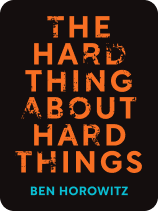

This article is an excerpt from the Shortform book guide to "The Hard Thing About Hard Things" by Ben Horowitz. Shortform has the world's best summaries and analyses of books you should be reading.
Like this article? Sign up for a free trial here .
Is your business growing but you’re keeping the same managers? How could this be holding you back? Why does scaling your business mean you may need to replace once-valuable team members?
Managing a 5-person team is very different from running a 100-person global sales force. Whenever your company scales, you should be reevaluating your employees. It may be difficult to replace somebody who has done a great job in the past, but you owe it to your company to find the best person for each job.
Keep reading to learn what changes you should make when scaling your business.
Not Everyone Scales
As your company grows, the job requirements for every manager changes. Being the company’s only salesperson is very different from running a 5-person sales team, which is in turn very different from running a 100-person global sales force.
Every time your company scales, people (especially executives) need to requalify for their job. What used to work at a smaller stage may no longer work at a larger stage.
You may feel disloyal to an executive who has done a tremendous job to date. But you don’t owe her the job. You owe it to the rest of the team to build a world-class team, so that everyone has a better chance of succeeding.
This applies to you as well. As the company scales, you may not be the best person to run the company, and for the sake of the company you might need to replace yourself.
Scale Anticipation
As you ponder how your company will scale in the next few years, you may try to predict who on your team will work well at the larger scale and who will not.
Ben thinks this prediction is counterproductive, primarily because operating at scale is a learnable skill, not a natural talent. Therefore, it’s hard to predict how someone will perform at a scale they (and you) have never seen. For example, it was never clear whether Mark Zuckerberg or Bill Gates could scale beyond a small startup, yet they both learned to oversee tens of thousands of employees.
Prematurely judging someone as incapable causes real damage:
- It will affect how you train them, thus causing a self-fulfilling prophecy. If you think certain people aren’t cut out for scale, then you won’t bother to coach them, which will make them even less fit for scale.
- In the interim period, you will feel guilty working with them, because you suspect their days are numbered.
- You’ll prematurely hire execs who are competent at larger stages. As we’ve covered, they’ll be useless for months until you hit that scale.
Instead, judge each person on the work they’re doing today. When it comes time to scale, evaluate what your company needs then and who can best do the job at that moment. Everything further in the future carries too little information to make good decisions right now.
Organizational Design
As your company grows, how should you design how everyone fits together? Do you group people by functions (such as sales, marketing, product) or do you group by business line?
The general idea is that people who report to the same manager communicate the most. The farther away teams are in the org chart, the harder it is to communicate.
Every company needs its own organizational answer. Here’s how to design yours:
- Identify what knowledge needs to be communicated, and who needs to hear it. For example, a product’s technical performance needs to be understood by engineering, product management, sales, marketing, and customer support.
- Identify what decisions need to be made frequently. Examples of decision types include which features to build, how to announce product improvements, and personnel changes.
- Put the most important communication paths and decisions in one group. This will improve productivity by reducing communication overhead.
- Decide who’s going to run the group. Note how you should only pick the manager after you design the organization, not the other way around.
- Mitigate the communication paths and decisions you did not optimize for. You can build processes that allow people in different groups to communicate and make decisions, even if they’re not in the same team.

———End of Preview———
Like what you just read? Read the rest of the world's best book summary and analysis of Ben Horowitz's "The Hard Thing About Hard Things" at Shortform .
Here's what you'll find in our full The Hard Thing About Hard Things summary :
- What it was like to head a company through the dotcom bubble and subsequent burst
- Why failing is normal
- How to build a good place to work






